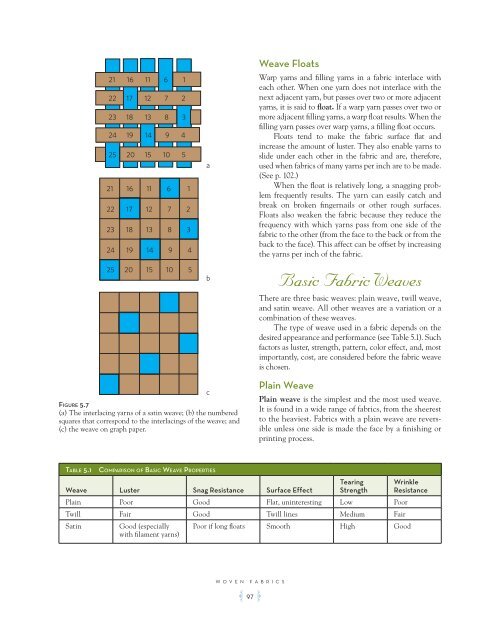Create successful ePaper yourself
Turn your PDF publications into a flip-book with our unique Google optimized e-Paper software.
21 16 11 6 1<br />
22 17 12 7 2<br />
23 18 13 8 3<br />
24 19 14 9 4<br />
25 20 15 10 5<br />
21 16 11 6 1<br />
22 17 12 7 2<br />
23 18 13 8 3<br />
24 19 14 9 4<br />
25 20 15 10 5<br />
Figure 5.7<br />
(a) The interlacing yarns of a satin weave; (b) the numbered<br />
squares that correspond to the interlacings of the weave; and<br />
(c) the weave on graph paper.<br />
Table 5.1 Comparison oF basiC Weave properTies<br />
a<br />
b<br />
c<br />
WOVEN FABRICS<br />
A 97 F<br />
Weave Floats<br />
Warp yarns and filling yarns in a fabric interlace with<br />
each other. When one yarn does not interlace with the<br />
next adjacent yarn, but passes over two or more adjacent<br />
yarns, it is said to float. If a warp yarn passes over two or<br />
more adjacent filling yarns, a warp float results. When the<br />
filling yarn passes over warp yarns, a filling float occurs.<br />
Floats tend to make the fabric surface flat and<br />
increase the amount of luster. They also enable yarns to<br />
slide under each other in the fabric and are, therefore,<br />
used when fabrics of many yarns per inch are to be made.<br />
(See p. 102.)<br />
When the float is relatively long, a snagging problem<br />
frequently results. The yarn can easily catch and<br />
break on broken fingernails or other rough surfaces.<br />
Floats also weaken the fabric because they reduce the<br />
frequency with which yarns pass from one side of the<br />
fabric to the other (from the face to the back or from the<br />
back to the face). This affect can be offset by increasing<br />
the yarns per inch of the fabric.<br />
Basic Fabric Weaves<br />
There are three basic weaves: plain weave, twill weave,<br />
and satin weave. All other weaves are a variation or a<br />
combination of these weaves.<br />
The type of weave used in a fabric depends on the<br />
desired appearance and performance (see Table 5.1). Such<br />
factors as luster, strength, pattern, color effect, and, most<br />
importantly, cost, are considered before the fabric weave<br />
is chosen.<br />
Plain Weave<br />
Plain weave is the simplest and the most used weave.<br />
It is found in a wide range of fabrics, from the sheerest<br />
to the heaviest. <strong>Fabrics</strong> with a plain weave are reversible<br />
unless one side is made the face by a finishing or<br />
printing process.<br />
Tearing Wrinkle<br />
Weave Luster Snag Resistance Surface Effect Strength Resistance<br />
Plain Poor Good Flat, uninteresting Low Poor<br />
Twill Fair Good Twill lines Medium Fair<br />
Satin Good (especially<br />
with filament yarns)<br />
Poor if long floats Smooth High Good













